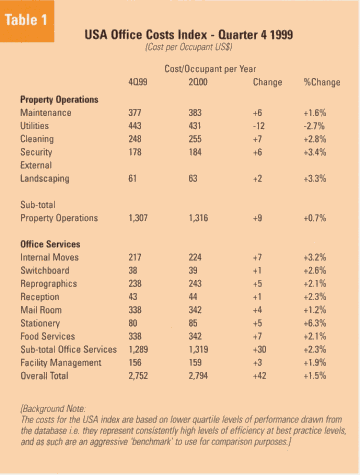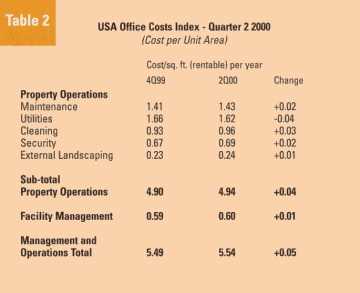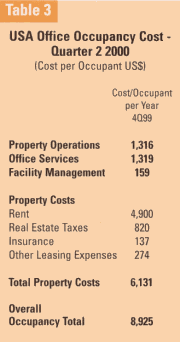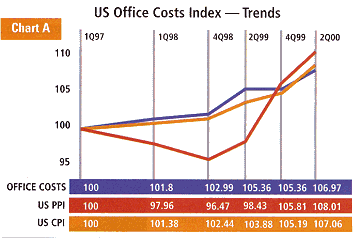The Johnson Controls USA Office Costs Index
[See Tables One, Two, Three and Chart A for data]
 The Johnson Controls USA Office Occupancy Costs Index is based on a detailed model of a medium grade air-conditioned office building, which operates reasonably efficiently with no unusually high service standards or demands. The building is 160,000 rentable square feet in size, and houses 600 occupants working between 8am and 6pm 5 days a week. Figures reported reflect changes from the 4th Quarter 1999 (end December) to the 2nd Quarter 2000 (end June). It does not analyze changes in the cost of rents, local taxes, service charges, insurance, depreciation, small project works, IT and any capital investments/purchases, as variations in the level of these costs are too case specific to monitor in this way. Notional sums for some of these property costs have been added in a separate analysis, however, to give a representation of the total occupancy cost for the model facility.
The Johnson Controls USA Office Occupancy Costs Index is based on a detailed model of a medium grade air-conditioned office building, which operates reasonably efficiently with no unusually high service standards or demands. The building is 160,000 rentable square feet in size, and houses 600 occupants working between 8am and 6pm 5 days a week. Figures reported reflect changes from the 4th Quarter 1999 (end December) to the 2nd Quarter 2000 (end June). It does not analyze changes in the cost of rents, local taxes, service charges, insurance, depreciation, small project works, IT and any capital investments/purchases, as variations in the level of these costs are too case specific to monitor in this way. Notional sums for some of these property costs have been added in a separate analysis, however, to give a representation of the total occupancy cost for the model facility.
Costs have been measured in terms of the cost per occupant per year for all services (Table One), and in addition in terms of cost per rentable square feet (Table Two) for those services where a buildings area can be a significant cost driver. The cost per occupant measure is considered to be the more meaningful of the two from a business perspective, as for all services it is that which is most closely aligned to the primary purpose of the facility from the users perspective i.e. the productive support of people. Table Three shows, on a cost per occupant basis, a notional calculation of the total occupancy cost.
The Index (Table One) shows that, in overall terms, it now typically costs $2,794 each year to service an office-based employee at a place of work. Over the 6-month period since the last index this has increased by $25,200. In terms of the model facility with 600 occupants, this equates to a total annual cost of $1,676,400. Adding in the property costs gives a total occupancy cost (Table Three) of $8,925 per occupant, which this equates to a total annual cost of $5,355,000 for the model facility.
 Key Points To Note(2nd Quarter 2000)
Key Points To Note(2nd Quarter 2000)
• Maintenance: costs for labor have continued to rise, increasing by nearly 2%. The cost of materials has reversed decreases over the last period, increasing in over the six-month period by just over 1%.
• Energy & Water: Electricity costs have continued to fall over the period, but at 3.2% this is at a lower rate than last time. Gas prices have levelled off, following an increase previously. The far greater significance of electricity costs, however, has meant that the energy and water index overall has reduced by approximately 3%.
• Cleaning: labor costs have increased significantly, by over 3%. Materials costs have fallen slightly, leading to an overall increase over the period of nearly 3%.
• Security: as with cleaning labor costs have risen significantly more than in the last period.
• External Landscaping: Equipment costs have risen slightly, but labor cost rises account for most of the overall 3.3% increase.
 • Internal Moves: labor costs both for operatives and the management function continues to rise, increasing the index by over 3% over the period. The big difference from the last 2 indices is that the increase in operative costs is greater than that for the management.
• Internal Moves: labor costs both for operatives and the management function continues to rise, increasing the index by over 3% over the period. The big difference from the last 2 indices is that the increase in operative costs is greater than that for the management.
• Reprographics: equipment costs have once again remained relatively stable, but increases in paper costs have accelerated over the period to well over 5%.
• Mail Room: labour costs have pushed up significantly, leading to an increase overall of over 1 percent.
• Stationery: the continued rise in paper prices has increased costs by over 6%.
• Food Services: both labor and food costs have increased by approximately 2%.
• Facility Management: labor costs for management have risen again, and at an accelerated rate of over 2%, compared with the more modest rate of 1.3% in the previous period.
 Trend
Trend
Chart 4 shows how the Johnson Controls Office Costs Index has shown the changing level of underlying facility costs over the last 3 years. This shows how the rate of increase in office costs has fallen into line with those of producer prices and consumer prices. In particular it is interesting to observe how producer prices have jumped over the last year. This could fuel inflation in facilities costs in the future as the effect of these are passed onto corporate buyers when contracts are renewed. Alternatively the industry may find ways to improve productivity so that they are, at least for the most part, absorbed.